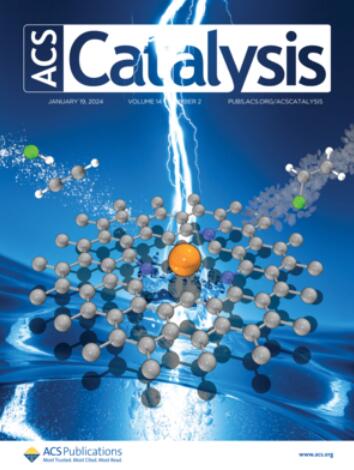具有配位不饱和Ti(Zr) -O酸碱对的Zr掺杂TiO2-x纳米氧化物用于丙烷高效脱氢
IF 11.3
1区 化学
Q1 CHEMISTRY, PHYSICAL
引用次数: 0
摘要
近年来,人们发现一些传统的氧化物载体,如具有高表面能的纳米TiO2和ZrO2,可以部分还原生成氧空位和配位不饱和金属(Mcu)阳离子,作为非氧化丙烷脱氢(PDH)的有效活性位点。然而,在工业应用中面临的主要挑战是在高温和可还原气氛的反应条件下,由于结焦、过度还原和聚集而导致的快速失活。本文报道了采用简单共沉淀法制备的经济环保的zr掺杂TiO2 (TixZr1)可作为高效稳定的PDH催化剂。在550℃下,Ti3Zr1的C3H6生成速率[r(C3H6)]为0.6 mmol g-1 min-1,是纯TiO2的17倍,失活常数(Kd)比商品TiO2低2.8倍。适度的Zr掺杂促进了表面活性点阵氧的生成,在较低的温度下可以还原形成氧空位和Ti(Zr) cu-O酸碱对作为PDH的活性位,其数量与TixZr1催化剂的r(C3H6)一致。随着Zr掺杂量的增加,TixZr的体晶相通过Ti2ZrO6逐渐由掺Zr锐钛矿TiO2转变为TiZrO4,热稳定性增强,可以抑制纳米氧化物的过还原和聚集。本文章由计算机程序翻译,如有差异,请以英文原文为准。

Zr-Doped TiO2–x Nano-Oxide with Coordinatively Unsaturated Ti(Zr)–O Acid–Base Pairs for Efficient Propane Dehydrogenation
Recently, some traditional oxide supports, such as nano TiO2 and ZrO2 with high surface energy, have been found to be partially reduced to generate oxygen vacancies and coordinatively unsaturated metal (Mcu) cations as efficient active sites for nonoxidative propane dehydrogenation (PDH). However, the primary challenge in their industrial applications is rapid deactivation because of coke, over-reduction, and aggregation under the reaction conditions of high temperature and reducible atmosphere. Herein, we reported that cost-effective and environmentally friendly Zr-doped TiO2 (TixZr1) prepared by a simple coprecipitation method can be used as a highly efficient and stable catalyst for PDH. Ti3Zr1 exhibited the C3H6 formation rate [r(C3H6)] of 0.6 mmol g–1 min–1 at 550 °C, which was 17 times that of pure TiO2, and a deactivation constant (Kd) 2.8 times lower than that of commercial TiO2. Moderate Zr doping promotes the generation of surface active lattice oxygen, which can be reduced at a relatively low temperature to form oxygen vacancies and Ti(Zr)cu–O acid–base pairs as the active sites for PDH, and their number is in line with r(C3H6) of TixZr1 catalysts. With the increase of the Zr doping amount, the bulk crystal phase of TixZr gradually transforms from Zr-doped anatase TiO2 to TiZrO4 via Ti2ZrO6 with enhanced thermostability, which can inhibit over-reduction and aggregation of the nano-oxide.
求助全文
通过发布文献求助,成功后即可免费获取论文全文。
去求助
来源期刊

ACS Catalysis
CHEMISTRY, PHYSICAL-
CiteScore
20.80
自引率
6.20%
发文量
1253
审稿时长
1.5 months
期刊介绍:
ACS Catalysis is an esteemed journal that publishes original research in the fields of heterogeneous catalysis, molecular catalysis, and biocatalysis. It offers broad coverage across diverse areas such as life sciences, organometallics and synthesis, photochemistry and electrochemistry, drug discovery and synthesis, materials science, environmental protection, polymer discovery and synthesis, and energy and fuels.
The scope of the journal is to showcase innovative work in various aspects of catalysis. This includes new reactions and novel synthetic approaches utilizing known catalysts, the discovery or modification of new catalysts, elucidation of catalytic mechanisms through cutting-edge investigations, practical enhancements of existing processes, as well as conceptual advances in the field. Contributions to ACS Catalysis can encompass both experimental and theoretical research focused on catalytic molecules, macromolecules, and materials that exhibit catalytic turnover.
 求助内容:
求助内容: 应助结果提醒方式:
应助结果提醒方式:


